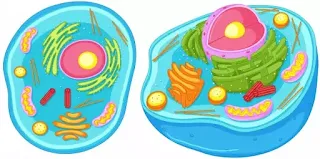What is Prokaryotic Cell ?
The Prokaryotic cells are small ,simple and most primitive. They are probably the first to come in existence. Stromatolites are on of the best example. Prokaryotic Cells generally found in bacteria like Mycoplasma, Cyanobacteria (Blue-green Algae) etc.
Prokaryotic cell is essentially a single enveloped system organized in depth. It is consists of central nuclear component like DNA,RNA molecule and nuclear proteins, surrounded by cytoplasmic ground substances.
The whole Protoplasm is surrounded by a lipid bi-layer called Plasma Membrane or Plasma lemma or Cell membrane. Neither the nucleoplasm material nor the cytoplasmic material are enclosed by any membrane system.
Structures And Features Of Prokaryotic Cell
1.Capsule Most of the bacteria bears an outer covering called capsule to protect Their Cell. Capsule is also known as Glycocalyx. It constitute of polysaccharides, which may be homo or hetero polysaccharide. Species of Streptomycin shows homo-polysaccharide in their capsule composition.
2.Cell Wall It is the outer membrane just after plasma membrane which is found in almost all types of bacteria .It is made up of lipids, polysaccharides and Teichoic acid. On the basis of cell wall composition and staining properties, bacteria are of two types -
(i)Gram Positive Bacteria Cell wall is thick ,contain high amount of lipopolysaccharide and stained as violet in color. ex-Lactobacillus, Clostridium.
(ii) Gram Negative Bacteria Cell wall is thin ,contain low amount of lipopolysaccharide and stained as red in color. ex- E.coli, Rhizobium.
3.Plasma membrane It is the innermost phospholipid bilayer which accommodate all cytoplasmic contents.
(i) It helps in the nuclear division i.e. DNA replication.
(ii) It also helps in septum formation between two bacteria during binary fission.
(iii) All though not exactly but to some extent it functions like mitochondria i.e. Helps in cellular respiration. Enfolding in mesosomes increases the surface area for transport system.
5.DNA ( Nucleoid ) The genetic material in bacteria is double stranded DNA. The DNA with the help of some basic proteins folded to form a chromatin like structure called nucleoid.
6.Polysomes Though the life span of bacteria is very limited, so the rate of protein synthesis is quite higher in comparison to an Eukaryotic cell . In cytoplasm most of the mRNA molecules are arranged with ribosome for protein synthesis. These structure are called Polysomes.
6.Fimbriae Or Pili These are some hairy outgrowths of bacteria emerging out from plasma membrane. They help in the sexual reproduction i.e. conjugation by forming conjugation bridge or sex-pilus between two bacteria for genetic transfer.
7. Flagella These are the locomotive structure of bacteria, which helps them to to search food or to show any chemotactic movement.
Eukaryotic Cells
The Eukaryotic cells are the true cells which occurs in plants and animals . Though all the eukaryotic sells have different shape and size and physiology.
More Topics
Tags:
Science
